|
LEM214 DXpedition Report
October 29 - November
5, 2005
by Mika
Mäkeläinen
We had sky-high expectations for
this DXpedition as fellow hobbyists before us in
October had experienced some of the best conditions
of the decade. The 214th DXpedition to Lemmenjoki
proved to be a success, although AM stations for
example from New Zealand and Samoa remained unheard
during this particular week. We both logged new
countries, and enjoyed some really neat conditions
to China, Cuba, Mexico and Oceania. Also some interesting
new equipment was used for the first time.
Jim
Solatie and I were in such a hurry to reach
Lemmenjoki that instead of the usual train ride
we drove all the way from Helsinki to Lapland -
1100 kilometers (680 miles) one way. The point was
to be able to set up our gear early enough around
midday Saturday so that we wouldn't miss the early
hours of the afternoon. Prime time for DXing Oceania
was predicted to be around 1000-1200 UTC, and this
would be a major target area.
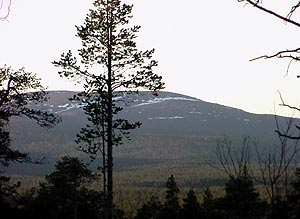
A scene from Lemmenjoki on the only sunny day
of the week |
Jim picked me up in Vantaa on
Friday (Oct 28) morning at 9.30, and we managed
to reach the ski resort of Levi at 11 p.m., staying
overnight at Hotel Levitunturi. From there, we would
only have some 160 kilometers left to Lemmenjoki.
Our journey across the unseasonably warm Finland
was supposed to be made smoother by exploring local
culinary delights on the way, but the only experience
Jim still remembered after a week of DXing was the
overly peppered and therefore uneatable pasta he
tried in Pulkkila, close to the geographical center
of Finland. It must be added however that most often
the problem is the lack of any spices. Anyhow, it
was another average small community with average
Finnish food, which was deservedly derided by Prime
Ministers Jacques Chirac and Silvio Berlusconi last
summer.
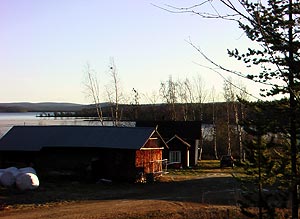
Where's all the snow? |
In Levi we did our own shopping
which certainly wouldn't score any culinary points
either, but at least it would be quick to prepare,
which was the most important criteria during a week
of intense DXing. Overnight the weather had turned
nasty with constant rain and above-freezing temperatures
making the last stretch really slippery, with water
on ice nearly doubling our travel time. At least
we didn't hit any reindeer, and spotted a moose
crossing the road ahead of us at a safe distance.
Hannu Asikainen and Hannu Niilekselä,
the previous pair of DXers, were already waiting
in their car in Lemmenjoki and left as soon as we
arrived at 11:45 a.m. on Saturday. This was a bad
omen, as a fanatic DXer would never abandon his
post earlier than necessary (12 noon) if there was
even a remote chance to hear anything at all. Indeed,
after a traditionally hectic hour of unpacking and
setting up the equipment, it seemed that the AM
dial was dead quiet. However, an hour later we caught
some action from the North-Western corner of the
US and some scattered East Asian stations.

Reindeer are not supposed to be dangerous... |
Reception conditions changed
radically during our stay. The first half of the
week under quiet geomagnetic conditions offered
nice reception of Mexico, Cuba, USA and Oceania,
while reception to these areas was very limited
after Wednesday (Nov. 2) when a coronal hole disrupted
long-distance AM reception. Reception of Asian stations,
and especially China, however remained very good
on most days, even under the more disturbed conditions.
Since there was something interesting taking place
on the mediumwave dial most of the time, we hardly
even turned to tropical shortwave, which was mostly
dead anyway.
Here is a detailed look at the
propagation conditions day-by-day:
Saturday, October 29:
Soon after our arrival US West Coast stations were
heard at 1200-1400 UTC along with a couple of Hawaiian
stations. As the Western stations faded out, East
Coast Australian X-band stations were heard around
1500-1645, a relatively late timing. Radio 16 NTC
from Canberra on 1647 kHz was one of the highlights.
The first Brazilian AM stations surfaced at 2140
UTC and first US stations at 2230 UTC - early enough
for daytimers, but we had no such luck.

... unless this is counted. |
Sunday, October 30:
Sunday was overall a very good day. Overnight
conditions offered stations from La Plata in South
America and the Great Lakes in North America, but
not much in between. This is very typical to Lapland.
The peak DXing time to the Western hemisphere coincided,
as usual, with daybreak, and at 0600-0700 UTC also
some stations from the Caribbean were logged. At
the same time, conditions within the US switched
to the West Coast, again a very typical pattern.
We caught some neat stations from the Rockies on
the lower end of the AM dial, which rarely really
opens up. The first Japanese stations showed up
just before 1000 UTC, and an hour later Chinese
stations were heard. At the same time Tahiti on
738 kHz appeared briefly, and conditions to Washington
and Oregon continued unabatedly, making it difficult
to choose which area to concentrate on. One of the
most interesting catches was KXMG Portland OR on
1150 kHz, which was surprisingly strong, on par
with KKNW Seattle WA. Generally conditions to Asia
were average and ended early. In the evening, the
first trans-Atlantic stations were heard around
2250 UTC.

Lingonberries |
Monday, October 31:
Overnight conditions weren't spectacular before
a short peak to Chile around 0300 UTC. Sunrise was
again the most hectic time of the day. Stations
from Argentina, Uruguay and Brazil peaked at 0630-0650
UTC before disappearing and making room for Madeira
(on an easily recognizable split frequency of 1529.87
kHz) and Cuba, which offered a bunch of stations
in the lower end of the dial. Again on Monday the
first Japanese stations appeared just in time for
the 0950 UTC NHK1 regional break, and we netted
for example JOPG Kushiro on 585 kHz. Soon Chinese
stations appeared on dozens of frequencies, while
West Coast US was audible until around 1400 UTC.
Local transmissions from Iran were hunted until
1630 UTC, when all stations returned to national
programming. In the evening we saw beautiful northern
lights across the sky, and the Boston superpower
station WWZN on 1510 kHz made a brief appearance
already at 1854 UTC, which was truly amazing. Much
later, the first US stations appeared just before
2300 UTC, giving a sharp and brief opening to Tennessee,
including one daytimer (WHEW Franklin TN 1380 kHz).
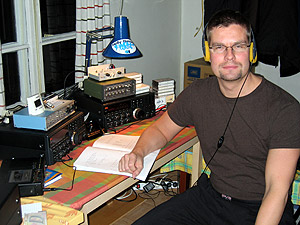
Jim Solatie |
Tuesday, November 1:
Trans-Atlantic signals disappeared soon after
midnight, leaving hardly anything interesting on
the AM band. Again, however, daybreak brought excellent
conditions to Cuba (for example Radio Sancti Spíritus
on 1200 kHz), and we were also lucky to hear the
sign-off announcement of KUAU Haiku HI (1570 kHz)
at 0800 UTC. Around 0900-1030 UTC we were out fixing
antennas, which in hindsight was just about the
worst possible timing, because exactly at that time
fellow DXers in Parkalompolo in Northern Sweden
captured some really rare Hawaiian stations. Anyhow,
also the rest of Tuesday was really good in terms
of Oceania, with Fiji heard on several frequencies
(639, 1152 and 1467 kHz) and Tonga with good reception
quality until close-down at 1105 UTC. Japanese stations
surfaced around 1145 UTC, an hour later than on
Monday, just as the NHK1 regional broadcast was
about to begin. Mediocre reception of US West Coast
stations continued at the same time. After 1200
UTC some Philippine stations and X-band Australians
joined the crowd, overwhelming our capacity to monitor
everything at the same time. As the afternoon progressed,
Chinese stations became stronger, and were reported
all the way from 1200 to 1600 UTC, completing one
of our best Asian afternoons ever. In the evening,
the first Brazilians were noted already at 2100
UTC, but still conditions to South America didn't
rise above average.
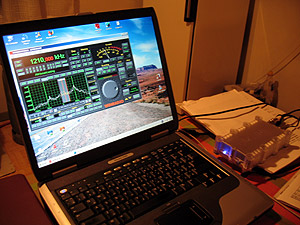
Winradio G313e |
Wednesday, November 2:
After a poor to mediocre overnight, 0600-1200
UTC turned out to be a great opening to the Western
hemisphere. First Cuba was audible, followed soon
by a couple of Texan stations and especially Mexicans
(such as XECH Toluca ME 1040 kHz, XETOT Tampico
TM 1190 kHz and XEWE Irapuato GJ 1420 kHz). Mexicans
seemed to pop up all over the dial, especially from
around the capital Mexico City. In the midst of
all this, Kiribati (846 kHz) was noted for the first
time in Finland when it closed down at 1003 UTC.
North America vanished by 1400 UTC, and Asia was
non-existent for a change. In the evening, WWKB
Buffalo NY 1520 kHz was heard at 2200 UTC, but conditions
remained mediocre, and stations soon faded out with
only a few South American remaining on the dial.
Thursday, November 3:
When we woke up at 0550 UTC, nothing was heard
from across the Atlantic. This was a stark contrast
to the earlier half of the DXpedition, but was not
unexpected, as the radio silence was a result of
a coronal hole and arrived as predicted. In a way
the lull in conditions was welcome as it gave us
ample time to work on the antennas, some of which
were more or less shredded by ongoing timber work
in the surrounding forest. In the end Asia saved
the day; first a few Japanese stations were heard,
followed by a barrage of Chinese stations at 1200-1600
UTC.
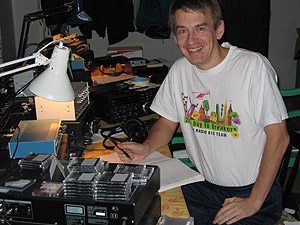
Mika Mäkeläinen
|
Friday, November 4:
As a sign of disturbed conditions, Ikwekwezi
FM from South Africa was logged overnight on 1098
kHz. A few stations were heard from southern South
America in the wee hours, but again nothing from
the Western hemisphere around daybreak. The afternoon
offered a decent selection of Japanese and Chinese
stations, making this an exceptionally productive
DXpedition as far as Asian stations are concerned.
Surprisingly, a couple of Hawaiian stations were
noted in the late afternoon (including KHBC Hilo
on 1060 kHz).
Saturday, November 5:
Just as on the previous nights, a fair selection
of stations from the southern half of South America
made its way to Lemmenjoki. A surprising exception
was picking up Mexican XEHI Cd. Miguel Alemán
TM on 1470 kHz, while nothing else from anywhere
near was noted. Just before 0600 UTC, US stations
made a brief appearance, but soon the AM dial was
completely empty. We started packing a couple of
hours earlier than planned as it was evident that
nothing more could be expected.
Space weather indices:
| Date |
Solar
flux |
Sunspot
number |
Planetary
A index |
K
indices (3-hour intervals) |
Min-max
solar wind speed (km/sec) |
Number
of flares (events) |
| STAR |
SEC |
STAR |
SEC |
Daily
low - high |
Planetary |
Boulder |
C |
M |
X |
| 29.10.2005 |
74.1 |
14 |
11 |
2.3 |
2 |
0-5 |
10100101 |
10201111 |
341-375 |
|
|
|
| 30.10.2005 |
75.6 |
16 |
14 |
4.8 |
5 |
2-9 |
22001012 |
21012311 |
314-357 |
|
|
|
| 31.10.2005 |
77.8 |
33 |
29 |
13.9 |
13 |
3-32 |
11123434 |
12133424 |
333-382 |
|
|
|
| 1.11.2005 |
77.3 |
32 |
33 |
7.9 |
8 |
0-15 |
32032311 |
32023322 |
308-369 |
|
|
|
| 2.11.2005 |
78.0 |
31 |
36 |
6.0 |
6 |
0-18 |
11000133 |
12002233 |
319-579 |
|
|
|
| 3.11.2005 |
76.8 |
0 |
24 |
23.5 |
24 |
12-56 |
35343434 |
35344434 |
568-657 |
|
|
|
| 4.11.2005 |
77.4 |
14 |
22 |
19.8 |
20 |
7-32 |
44333342 |
55434342 |
590-714 |
|
|
|
| 5.11.2005 |
79.3 |
35 |
18 |
10.0 |
10 |
3-27 |
23412212 |
23433322 |
579-756 |
|
|
|
(information
collected by Jan Alvestad)
Several pieces of new hardware
and software were tested on LEM214. For the first
time Mika dragged his laptop computer to Lemmenjoki
to be able to use Winradio G313e. A review
of the receiver can be found as a separate article.
Also, we had an enhanced version of Geoclock with
all the locations of North American AM stations,
programmed by Tapio Kalmi, which was really nice
in assessing changing conditions. I can imagine
it would have been even more useful if we had had
any real conditions to catch daytimers, to determine
the ideal time to listen to each station. Antenna
switchboxes made by Roland Sandberg and Stefan Wikander
proved to work well when we tried to take full advantage
of the huge amount of antennas (a total of 15 beverage
and longwire antennas). As far as receivers go,
we mostly relied on our traditional array of JRC
NRD-535 and NRD-545 receivers.
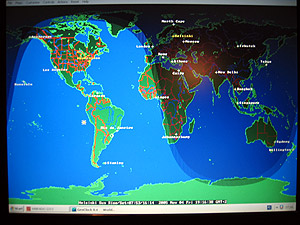
Geoclock (1716 UTC on Nov 4) shows that it is
time to get 3-4 hours of sleep before hunting
American stations. |
Weatherwise Lemmenjoki didn't
resemble any winter wonderland. Whatever was left
of the 30 cm (1 ft) of snow that arrived in October
melted away during our stay. Daytime highs and mostly
even nighttime lows were well above freezing point,
so staying warm was not an issue - but rain was.
We weren't prepared to work on the antennas soaking
wet.
Once again we got ample media
attention, this time from the local news media.
We accidentally ran into a YLE crew when shopping
in Inari during the week. Both the YLE local radio
station and the community newspaper Inarilainen
interviewed me. The YLE interview was primarily
for the Sami audience, so the interviewer, herself
a native Sami speaker, translated all of my comments
to Sami. It was a humbling experience to realize
that I don't have a clue of what is being said even
though this is a language spoken in Finland.
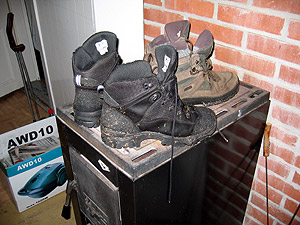
Trying to dry our boots without melting them... |
As we left earlier than usually,
we didn't get to see the incoming DXers, Jari and
Jussi Korhonen, but learned later that they arrived
safely. On Saturday we drove down to Levi, enjoyed
the luxuries of returning to civilization in the
form of a nice meal and massage, and took the train
ride back south. It would have been too risky to
drive down, tired as we were after a week of sleep
deprivation.
LEM214 was definitely one of
the most successful DXpeditions either one of us
has ever had. For details on the catches, check
out the LEM214 DXpedition
Log. It may also be interesting to compare what
DXpeditionists in Parkalompolo in Northern Sweden
heard
at the same time. I just wonder how many months
it will take to review the hundreds of hours of
recordings that we amassed. At least it will give
many opportunities to relive those memorable days
in Lapland.
Published
on November 11, 2005 (slightly edited later)
  
|